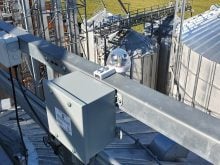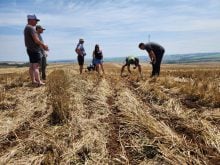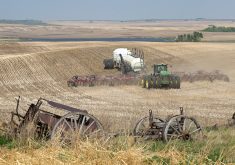BRANDON – Boron deficiencies can reduce pea and canola yield by as much as 30 percent.
The remedy often requires only a pound of active boron per acre, but how do producers know which areas need it?
Boron deficiency can be frustrating, says Rusty Stinn, a crop adviser with AgriTrend in Lethbridge. Producers pay for all their inputs in advance, “but then you start checking some pods just before harvest, and 20 to 30 percent of the peas in the pod are blank. That costs you a lot of money.”
Read Also

New Alberta funding for program hopes to further unlock agritourism industry in province
Alberta Farm Fresh Producers Association is launching a new initiative thanks to $300,000 of provincial funding to bolster Alberta’s smaller scale family farms and agritourism sector.
Stinn has worked with the Wild Rose Colony near Vulcan, Alta., for the past five years. Six of its fields are set up for variable rate, but the colony selected one particular problem field for an intensive boron variable rate experiment.
“Instead of zone sampling, we grid sampled the entire half section with one soil sample every five acres. It’s expensive, but now we have an extremely accurate zone map based on the soil itself rather than based on satellite images.
“With variable rate boron on canola and peas, we get better flowering and better pod fill. Where we used to see up to 30 percent blanks, now we see the pods fill right out completely.
“The yield bump depends on the weather of course, but we typically see a 10 to 15 percent yield bump on peas. Of course in bad years, you don’t see any benefit.”
Stinn said less than a third of the 320 acre field had sufficient boron levels for peas and canola.
The requirements for active boron per acre in the three deficient zones were 1.25, .75 and .50 pounds.
The colony used a 10 percent boron powder blend, so at the low rate it added five lb. of product per acre. The three levels were mixed in with the seed-place fertilizer and applied according to the prescription map.
“Once you’re set up for variable rate, the cost of applying boron is only $6 to $8 per acre, so you easily get a payback with just a bushel or two extra yield.
“A lot of farmers still think nitrogen is the fix-all. They throw on way more N than they need. But you hurt your crop if you throw on nitrogen without maintaining the right balance of boron, potassium and sulfur.”
Stinn said boron is normally available as a powder or granular to blend with other fertilizers. Some dealers carry boron liquid, which is impregnated into dry granular fertilizer.
For more information, contact Stinn at rstinn@agritrend.com.














